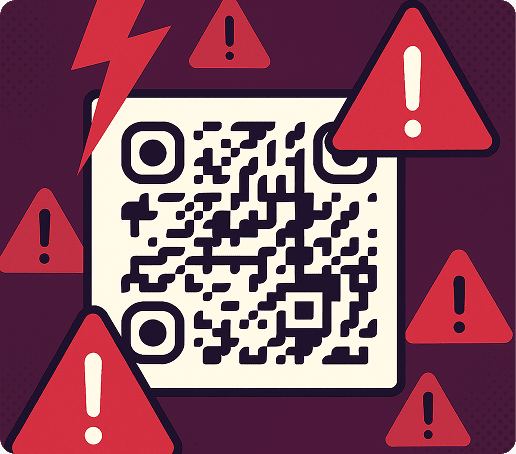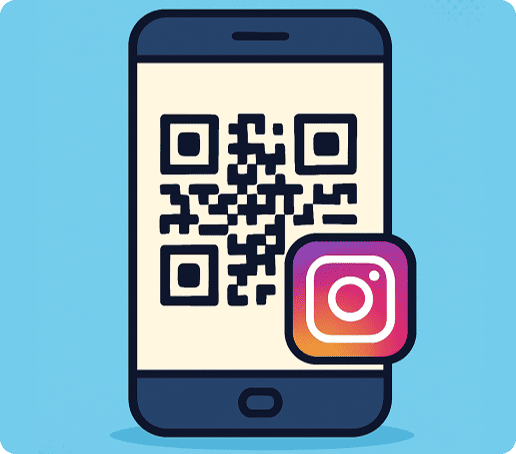What Is a Fake QR Code?
A fake QR code is created or changed to trick the user. Instead of taking your user to yourwebsite, it sends them to a fraudulent page designed to steal financial details, login credentials, or other confidential data.
Criminals exploit public spaces, marketing materials, or online channels to replace real codes with their malicious versions. If you are not careful, your business can risk losing customer trust, revenue, and data integrity if these are compromised.
Using safe QR code practices helps stop anyone from changing your codes and keeps your brand’s good name.
Recent trends in QR code phishing and fraud
Cybersecurity research has shown a sharp rise in “quishing” attacks, where phishing links are embedded in scannable codes. A study this year from a cybersecurity platform found that 26% of all malicious links are now sent via QR code, highlighting how attackers increasingly prefer this method for bypassing email and web security filters.
These scams often evade traditional detection tools, exploit user trust in visual formats, and reach large audiences quickly, making them harder for businesses to identify before damage occurs.
How To Identify a Fake QR Code
If you think one of your codes has been tampered with, or you want to scan one you’ve seen in public, spotting a QR code scam takes both a careful look and some technical know-how.
In a business setting, this should be a regular part of your security checks.
- Inspect for physical tampering: Look for stickers placed over printed materials or packaging that may cover the original code.
- Preview the URL: Use a scanner that allows you to view the link before opening it. Suspicious or shortened links should raise a red flag.
- Check the source: Only scan codes from trusted, verified campaigns or business partners.
- Avoid generic designs: Branded codes with your company colors or logo build trust and deter fraud. Consider using AI design apps to create custom QR codes that are easy to recognize.
How To Avoid QR Code Scams
Preventing QR code fraud is more effective than responding after an attack. By understanding how secure QR codes are generated, organizations can apply proven measures that safeguard data, maintain trust, and build lasting resilience against targeted threats.
- Use a reliable QR code creator: Select a platform with strong security protocols, encryption, and anti-tamper features for consistent safety, such as QRNow’s generator.
- Apply regular security updates: Ensure your scanning and mobile device software is always current to prevent exploitation through known vulnerabilities.
- Verify before entering data: Never provide personal details unless the code’s origin and purpose are fully confirmed.
- Avoid high-risk environments: Limit scanning codes placed in unsecured public locations or from unverified promotional materials.
Get started with your first QR code
Access our full QR generator for 7 days and design unique codes that help you connect with your audience.
Create my QR Code
Examples of Fake QR Code Scams
Fraudsters target both physical and digital platforms to reach a wide audience. By understanding their most common tactics, you can anticipate risks before they affect your campaigns.
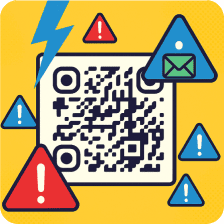
QR codes scam emails and text messages
Attackers send phishing emails or SMS messages containing fraudulent codes, often posing as banks, government agencies, or delivery services. These lead recipients to credential-harvesting sites and can result in severe financial or reputational damage.
Your business can protect staff by enforcing strict scanning policies, providing targeted awareness training, and using verified QR creation tools like dynamic URL QR Codes for internal communications.
QR code package scams
Fake labels are placed on shipped parcels to trick recipients into scanning for “delivery tracking.” This can install malware, harvest credentials, or prompt users to enter sensitive financial details. Criminals often target high-volume shipping operations to maximise reach.
Secure packaging with verified QR marketing materials for products and tamper-evident seals significantly reduces the risk of interception, manipulation, and unauthorized data capture during transit.
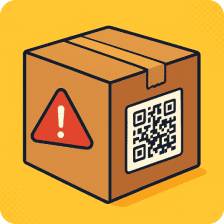
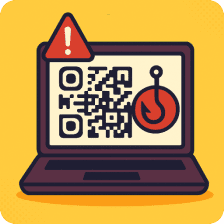
Fake QR code generators or scanning apps
Some malicious websites and apps claim to create or scan codes, but instead collect sensitive user data and expose devices to malware. These tools can compromise entire corporate networks if used internally.
Protect your company by relying on enterprise-grade platforms with compliance standards, strong encryption, and authentication features, such as business QR solutions that meet strict security requirements and support large-scale, secure deployments across multiple departments.
Social media posts
Scammers post attractive offers, contests, or giveaways containing fake QR codes. When scanned, they redirect to phishing pages, malicious apps, or prompt risky downloads that can compromise business accounts.
A QR code scam often spreads rapidly through shares and reposts, increasing exposure. To maintain control, use trusted social media QR code tools like Facebook, Instagram, or LinkedIn QR Codes that allow you to manage campaign links dynamically, track engagement, and immediately disable compromised content before it impacts your brand reputation.
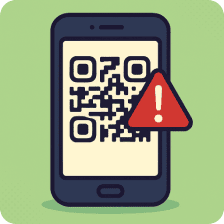
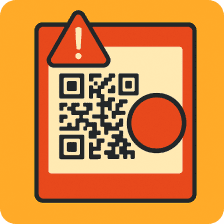
QR code phishing in public areas
Public posters, billboards, and event banners are prime targets for sticker overlays containing malicious codes. Criminals use these to target large crowds quickly, often at high-profile events or transport hubs.
Prevent this by printing on tamper-resistant materials, securing display areas, and using event QR code features that allow you to track scans, verify authenticity, and deactivate compromised links in real time.
FAQs
What happens when you scan a fake barcode?
Toggle faqs
Scanning a fake QR code can send you to a phishing site, start a harmful download, or trick you into giving away sensitive information. In serious cases, it can affect your device, network, and stored business data.
Understanding QR code expiration and control methods provides additional protection by ensuring outdated codes cannot be exploited by attackers to target your business or customers.
What do you do if you scanned a fake QR code?
Toggle faqs
Disconnect from the internet immediately, run a full security scan, and change any credentials you may have entered. Report the incident to your IT department for investigation.
Reviewing QR code editing and management best practices helps prevent repeat incidents by ensuring your company’s codes remain secure, up to date, and resistant to tampering across all marketing and operational materials.
How do you protect yourself from fake QR codes?
Toggle faqs
Only use codes from trusted sources, preview links before opening them, and keep scanning devices updated with the latest security patches. Enterprise campaigns should use secure PDF QR codes to share documents without risking redirection to fraudulent sites.
When you combine this with staff training, device security, and strict verification steps, you create strong layers of protection that greatly reduce the risk of falling for tampered QR codes, both online and offline.
Can someone take my money with a QR code?
Toggle faqs
Yes, if a QR code leads to a fake payment page or a copied payment system, criminals can steal your money by intercepting transactions or sending payments to their accounts. Only enter payment details if the code is fully verified and from someone you trust.
For safer transactions, you can use vCard QR codes to share contact and payment details securely, reducing the risk of QR code phishing attacks on your financial information.

